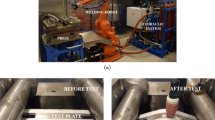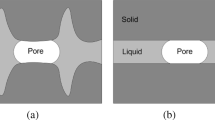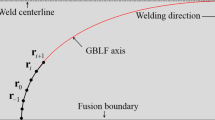Abstract
Welded components are used widely in power plants. Many of these components operate at high temperatures and under high pressures. Defects or micro cracks may be found in the vicinity of the welds. These micro cracks or voids can grow under creep cracking conditions. These cracks are often found in a narrow zone close to the interface between the parent material and the heat-affected zones (HAZ), known as the type IV region, or in some cases, in the weld metal. Welds are metallurgically complex, with heterogeneous structures within the weld metal and the HAZ. It is important to have knowledge of the initial metallurgical features and the associated material property variations so that it may be possible to accurately model the possible failure modes of welds using, for example, finite element (FE) numerical modeling techniques. This paper describes a procedure related to the determination of the high temperature creep properties for each sub-region of welds from experimental results, and it also describes the subsequent failure modeling of welds, using a creep damage mechanics approach in FE analyses. Typical examples, for P91 welds in power plant, are used to illustrate the applications.













Similar content being viewed by others
References
Alberry, P.J., Jones, W.K.C.: A computer model for the prediction of HAZ microstructures in multipass welds. Met. Technol. 9(10), 419–426 (1982)
Hyde, T.H., Sun, W., Becker, A.A.: Analysis of the impression creep test method using a rectangular indenter for determining the creep properties in welds. Int. J. Mech. Sci. 38(10), 1089–1102 (1996)
Hyde, T.H., Sun, W.: Determining high temperature properties of weld materials. Int. J. Solid Mech. Mater Eng. Ser. A 43, 408–414 (2000)
Hyde, T.H., Sun, W., Agyakwa, P.A., Shipway, P.H., Williams, J.A.: Anisotropic creep and fracture behaviour of a 9CrMoNbV weld metal at 650oC. In: Skrzypek, J.J., Ganczarski, A. (eds.) Anisotropic Behaviour of Damaged Materials, vol. 9, pp. 295–316. Springer Verlag, Berlin (2002)
Hyde, T.H., Sun, W., Williams, J.A.: Creep analyses of circumferential pipe weldments–a review. J. Strain Anal. 38(1), 1–29 (2003)
Hyde, T.H., Sun, W.: A study of anisotropic creep behaviour of a 9CrMoNbV weld metal using damage analyses with a unit cell mode. Proc. IMechE L J. Mater. Des. Appl. 219, 193–206 (2006a)
Hyde, T.H., Sun, W.: Creep failure behaviour of a P91 pipe weldment with an anisotropic weld metal under internal pressure and end load. J. Mater. Des. Appl. 220(2), 147–162 (2006b)
Hyde, T.H., Sun, W.: Determining creep properties for columnar and equiaxed regions of a 9CrMoNbV weld metal at 650°C using bulk uniaxial creep test data. In: Proceedings of the 3rd International Conference on Integrity of High Temperature Welds, April 2007, IoM Communications, London, pp. 139–148 (2007)
Hyde, T.H., Saber Hassan Badr, M., Sun, W.: Creep crack growth testing of a P91 weldment at 650°C using compact tension specimens. In: International Conference on WELDS 2009: Design, Testing, Assessment and Safety of High Temperature Welded Structures, Fort Myers, Florida, USA (2009)
Hayhurst, D.R.: Creep rupture under multi-axial states of stress. J. Mech. Phys. Solids 20, 381–390 (1972)
Hayhurst, D.R., Goodall, I.W., Hayhurst, R.J., Dean, D.W.: Lifetime predictions for high-temperature low alloy ferritic steel weldments. J. Strain Anal. 40(7), 675–701 (2005)
Kachanov, L.M.: On creep rupture time. Izv. Acad. Nauk SSSR, Otd. Tech. Nauk. 8, 26–31 (1958)
Kowalewski, Z.L., Hayhurst, D.R., Dyson, B.F.: Mechanisms-based creep constitutive equations for an aluminium alloy. J. Strain Anal. 29, 309–316 (1994)
Liu, Y., Murakami, S.: Damage localization of conventional creep damage models and propsition of a new model for creep damage analysis. JSME Int. J. 41(1), 57–65 (1998)
Murakami, S., Ohno, N.: A continuum theory of creep and creep damage. In: Ponter, A.R.S., Hayhurst, D.R. (eds.) Creep in Structures, pp. 422–444. Springer-Verlag, Berlin (1980)
Peravali, S., Hyde, T.H., Cliffe, K.A., Leen, S.B.: Development and use of an anisotropic damage model for the life assessment of a P91 weldment. J. Strain Anal. 43, 361–382 (2008)
Yaghi, A.H., Hyde, T.H., Becker, A.A., Sun, W.: Finite element simulation of welding and residual stresses in a P91 steel pipe incorporating solid-state phase transformation and post-weld heat treatment. J. Strain Anal. 43(5), 275–294 (2008)
Yaghi, A.H., Hyde, T.H., Becker, A.A., Sun, W.: Thermo-mechanical modelling of P91 steel weld microstructure and residual stresses in power plant pipework. In: 1st International Conference on Sustainable Power Generation and Supply, April 2009, Nanjing China
Acknowledgments
We would like to acknowledge the support of Engineering and Physical Science Research Council (EPSRC) through the Supergen 2 programme (GR/S86334/01 and EP/F029748) and the following companies: Alstom Power Ltd., Corus, E.ON Engineering Ltd., Doosan Babcock Energy Ltd., National Physical Laboratory, QinetiQ, Rolls-Royce plc, RWE npower, Sermatech Ltd. and Siemens Industrial Turbomachinery Ltd. for their valuable contributions to the project.
Author information
Authors and Affiliations
Corresponding author
Rights and permissions
About this article
Cite this article
Hyde, T., Sun, W. Some issues on creep damage modelling of welds with heterogeneous structures. Int J Mech Mater Des 5, 327–335 (2009). https://doi.org/10.1007/s10999-009-9105-7
Received:
Accepted:
Published:
Issue Date:
DOI: https://doi.org/10.1007/s10999-009-9105-7




